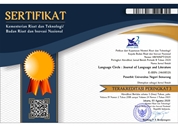OPTIMIZING THE USE OF CLASSROOM LANGUAGE TO IMPROVE THE SPEAKING CONFIDENCE OF STUDENTS AT BEGINNER LEVEL
(1) Semarang State University
Abstract
Teaching English to non-native students in Indonesia, especially pre and elementary school students, is farmore problematic than teaching adult students in the same country. These students are not accustomed touse English in their daily lives. When they are given English lesson at school, they often feel afraid, shy, andlack of confidence in using the target language. Students have those feelings mostly when they have topractice speaking English because they find it difficult as they have to master different elements of languagesuch as vocabulary, pronunciation, structures, functions and so on in order to say what they want (Phillips,1993). Consequently, teachers are strongly required to be more patient, to have more preparation time andto be more creative in designing classroom activities. Experts say that young learners are hard toconcentrate and easily distracted. If teachers are not able to manage their students, their classes willbecome chaotic and riotous ones. In order to minimize that condition, teachers need to make anyanticipation so that they, instead of their students, can take control of their classes. One of the ways is bymaking classroom language. This will help teachers to organize their classes and ultimately make theirstudents speak using the target language. This paper promotes classroom language as it is concrete,meaningful, and has communicative nature. Hughes (1990) states that the phrase ‘Open your books at page10, please’ does not make the students only repeat, translate, evaluate as true or false or put into negative,but this makes them do the simple action of opening a textbook after understanding the genuine instruction.Furthermore, classroom phrases help the students to use the target language in appropriate context andindirectly accustom them to the form-function relationships and discrepancies that are parts of English.Considering the phenomena above, this paper offers some techniques that may be used in applyingclassroom language. Some of those techniques include a lot of drilling techniques and fun games.Hopefully, this paper may become one of considerations to be used by EFL teachers in encouraging theirstudents to be able to speak the target language in most of their time in their English classes. However, thispaper is still far of perfection. It still needs a lot of suggestions and deeper discussion from those who aredealing with researches of the same topic.
Full Text:
PDFReferences
Hughes, G. S. 1990. A Handbook of Classroom English. Oxford: Oxford University Press.
Linse, C.T. 2006. Practical English Language Teaching: Young Learners. Singapore: Mc Graw-Hill ESL/ELT.
Paul, D. 2003. Teaching English to Children in Asia. Hong Kong: Longman Asia ELT.
Phillips, S. 1993. Young Learners. Oxford: Oxford University Press.
Scott, W. A. and L. H. Ytreberg. 1990. Teaching English to Children. New York: Longman Inc.
Refbacks
- There are currently no refbacks.

This work is licensed under a Creative Commons Attribution 4.0 International License

